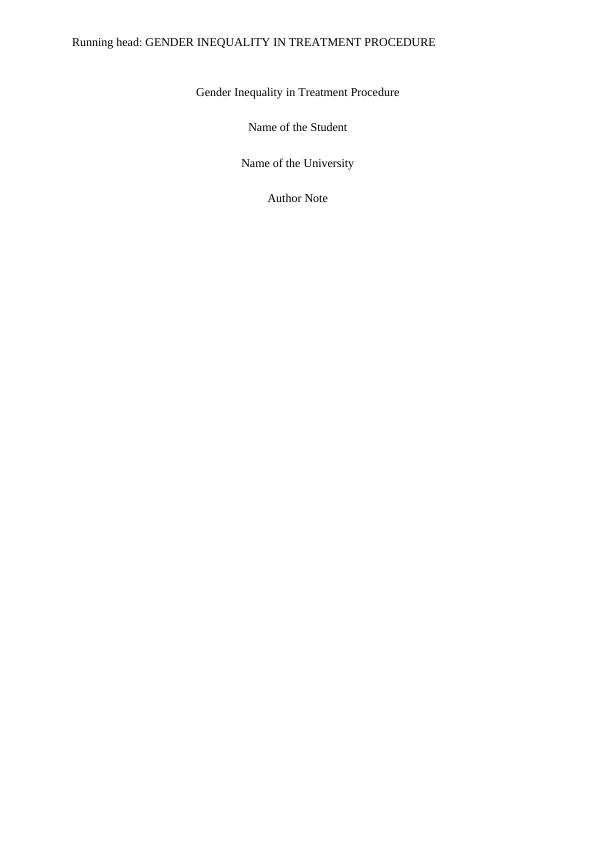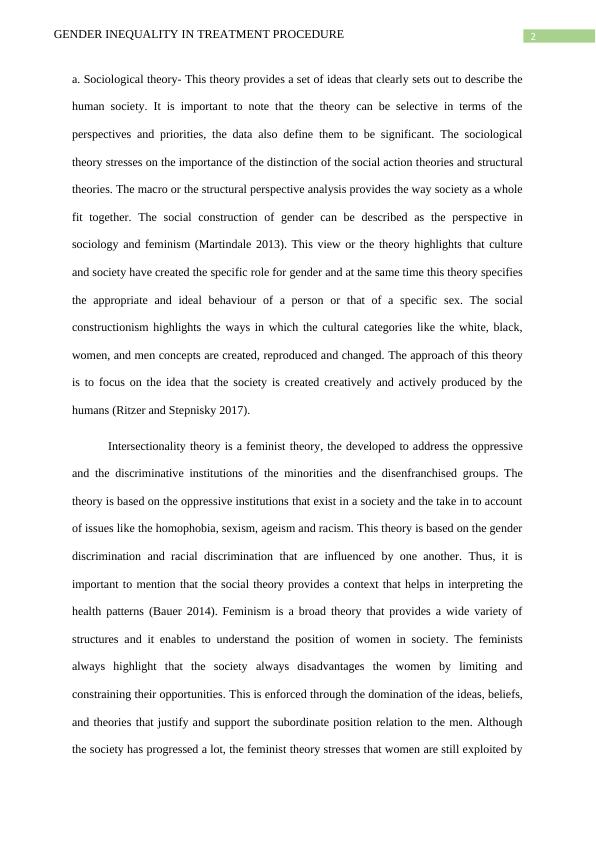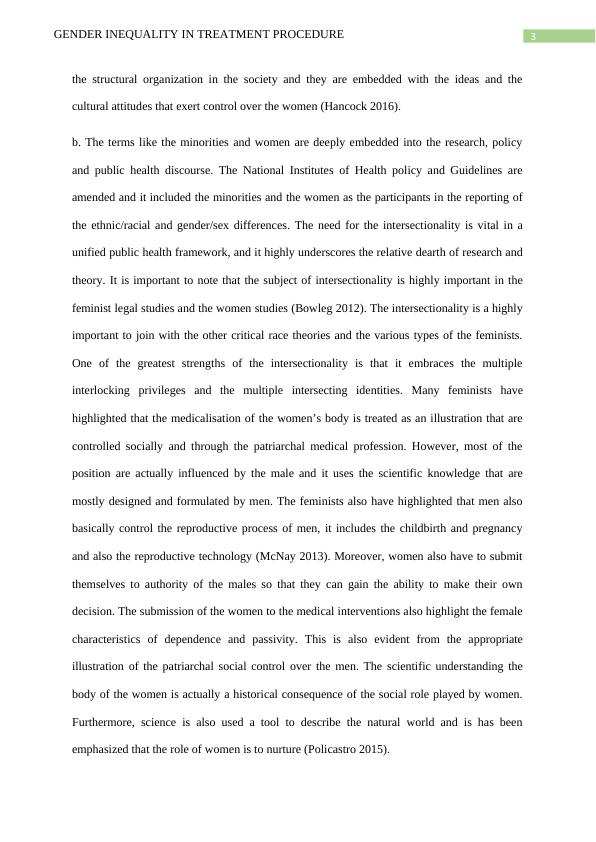Gender Inequality in Treatment Procedure
Added on 2023-01-13
13 Pages4109 Words1 Views
Running head: GENDER INEQUALITY IN TREATMENT PROCEDURE
Gender Inequality in Treatment Procedure
Name of the Student
Name of the University
Author Note
Gender Inequality in Treatment Procedure
Name of the Student
Name of the University
Author Note

1GENDER INEQUALITY IN TREATMENT PROCEDURE
Introduction
In society the concept of gender is very much prominent and in many segments of the society
the concept of gender inequality is very prominent. The term gender refers to the range of
characteristics that is responsible for differentiation of feminity and masculinity. Depending
on the characteristics, the concepts of biological sex also comes into play. The biological sex
mainly is divided into three different categories that are male, female and intersex variation.
The presence of different genders in the society is associated with the problem of gender
equality in the society of modern days. This problem of gender inequality exists in every area
of the world and UK is not far behind from this social trends. The concepts of gender is
greatly rooted in the society and as per the society culture, a few roles and responsibilities are
set for the male, female and transgender people. Therefore, the role of different genders are
differing from one culture to another and in some cases, even the cultures of two societies are
different. The concept of gender equality is very important in smooth running of a society.
Gender equality is the condition where all the genders that are male, female, and third
genders will have all the same facilities, opportunities, enjoys the rights of human rights. In
the health care sector, the problem of gender inequality is very prominent. Therefore, there
are many instances that suggests that the quality of care is different from men to women. In
addition to this, the condition of the quality of care for the transgender people are also not in
very condition. In addition, it is observed that in cases of delivery of care for the mental
health patients, the impact of gender in the treatment process is more prominent. The essay
discusses about the theorise of gender such as theory of intersectionality, regional social
theory, theory of social constructivism. In addition to this, the impact of gender on the
treatment of mental health patients are also highlighted. In the latter part of the essay, the
concept of intersectionality along with its impact on the treatment of the people are also
depicted in a brief manner.
Introduction
In society the concept of gender is very much prominent and in many segments of the society
the concept of gender inequality is very prominent. The term gender refers to the range of
characteristics that is responsible for differentiation of feminity and masculinity. Depending
on the characteristics, the concepts of biological sex also comes into play. The biological sex
mainly is divided into three different categories that are male, female and intersex variation.
The presence of different genders in the society is associated with the problem of gender
equality in the society of modern days. This problem of gender inequality exists in every area
of the world and UK is not far behind from this social trends. The concepts of gender is
greatly rooted in the society and as per the society culture, a few roles and responsibilities are
set for the male, female and transgender people. Therefore, the role of different genders are
differing from one culture to another and in some cases, even the cultures of two societies are
different. The concept of gender equality is very important in smooth running of a society.
Gender equality is the condition where all the genders that are male, female, and third
genders will have all the same facilities, opportunities, enjoys the rights of human rights. In
the health care sector, the problem of gender inequality is very prominent. Therefore, there
are many instances that suggests that the quality of care is different from men to women. In
addition to this, the condition of the quality of care for the transgender people are also not in
very condition. In addition, it is observed that in cases of delivery of care for the mental
health patients, the impact of gender in the treatment process is more prominent. The essay
discusses about the theorise of gender such as theory of intersectionality, regional social
theory, theory of social constructivism. In addition to this, the impact of gender on the
treatment of mental health patients are also highlighted. In the latter part of the essay, the
concept of intersectionality along with its impact on the treatment of the people are also
depicted in a brief manner.

2GENDER INEQUALITY IN TREATMENT PROCEDURE
a. Sociological theory- This theory provides a set of ideas that clearly sets out to describe the
human society. It is important to note that the theory can be selective in terms of the
perspectives and priorities, the data also define them to be significant. The sociological
theory stresses on the importance of the distinction of the social action theories and structural
theories. The macro or the structural perspective analysis provides the way society as a whole
fit together. The social construction of gender can be described as the perspective in
sociology and feminism (Martindale 2013). This view or the theory highlights that culture
and society have created the specific role for gender and at the same time this theory specifies
the appropriate and ideal behaviour of a person or that of a specific sex. The social
constructionism highlights the ways in which the cultural categories like the white, black,
women, and men concepts are created, reproduced and changed. The approach of this theory
is to focus on the idea that the society is created creatively and actively produced by the
humans (Ritzer and Stepnisky 2017).
Intersectionality theory is a feminist theory, the developed to address the oppressive
and the discriminative institutions of the minorities and the disenfranchised groups. The
theory is based on the oppressive institutions that exist in a society and the take in to account
of issues like the homophobia, sexism, ageism and racism. This theory is based on the gender
discrimination and racial discrimination that are influenced by one another. Thus, it is
important to mention that the social theory provides a context that helps in interpreting the
health patterns (Bauer 2014). Feminism is a broad theory that provides a wide variety of
structures and it enables to understand the position of women in society. The feminists
always highlight that the society always disadvantages the women by limiting and
constraining their opportunities. This is enforced through the domination of the ideas, beliefs,
and theories that justify and support the subordinate position relation to the men. Although
the society has progressed a lot, the feminist theory stresses that women are still exploited by
a. Sociological theory- This theory provides a set of ideas that clearly sets out to describe the
human society. It is important to note that the theory can be selective in terms of the
perspectives and priorities, the data also define them to be significant. The sociological
theory stresses on the importance of the distinction of the social action theories and structural
theories. The macro or the structural perspective analysis provides the way society as a whole
fit together. The social construction of gender can be described as the perspective in
sociology and feminism (Martindale 2013). This view or the theory highlights that culture
and society have created the specific role for gender and at the same time this theory specifies
the appropriate and ideal behaviour of a person or that of a specific sex. The social
constructionism highlights the ways in which the cultural categories like the white, black,
women, and men concepts are created, reproduced and changed. The approach of this theory
is to focus on the idea that the society is created creatively and actively produced by the
humans (Ritzer and Stepnisky 2017).
Intersectionality theory is a feminist theory, the developed to address the oppressive
and the discriminative institutions of the minorities and the disenfranchised groups. The
theory is based on the oppressive institutions that exist in a society and the take in to account
of issues like the homophobia, sexism, ageism and racism. This theory is based on the gender
discrimination and racial discrimination that are influenced by one another. Thus, it is
important to mention that the social theory provides a context that helps in interpreting the
health patterns (Bauer 2014). Feminism is a broad theory that provides a wide variety of
structures and it enables to understand the position of women in society. The feminists
always highlight that the society always disadvantages the women by limiting and
constraining their opportunities. This is enforced through the domination of the ideas, beliefs,
and theories that justify and support the subordinate position relation to the men. Although
the society has progressed a lot, the feminist theory stresses that women are still exploited by

3GENDER INEQUALITY IN TREATMENT PROCEDURE
the structural organization in the society and they are embedded with the ideas and the
cultural attitudes that exert control over the women (Hancock 2016).
b. The terms like the minorities and women are deeply embedded into the research, policy
and public health discourse. The National Institutes of Health policy and Guidelines are
amended and it included the minorities and the women as the participants in the reporting of
the ethnic/racial and gender/sex differences. The need for the intersectionality is vital in a
unified public health framework, and it highly underscores the relative dearth of research and
theory. It is important to note that the subject of intersectionality is highly important in the
feminist legal studies and the women studies (Bowleg 2012). The intersectionality is a highly
important to join with the other critical race theories and the various types of the feminists.
One of the greatest strengths of the intersectionality is that it embraces the multiple
interlocking privileges and the multiple intersecting identities. Many feminists have
highlighted that the medicalisation of the women’s body is treated as an illustration that are
controlled socially and through the patriarchal medical profession. However, most of the
position are actually influenced by the male and it uses the scientific knowledge that are
mostly designed and formulated by men. The feminists also have highlighted that men also
basically control the reproductive process of men, it includes the childbirth and pregnancy
and also the reproductive technology (McNay 2013). Moreover, women also have to submit
themselves to authority of the males so that they can gain the ability to make their own
decision. The submission of the women to the medical interventions also highlight the female
characteristics of dependence and passivity. This is also evident from the appropriate
illustration of the patriarchal social control over the men. The scientific understanding the
body of the women is actually a historical consequence of the social role played by women.
Furthermore, science is also used a tool to describe the natural world and is has been
emphasized that the role of women is to nurture (Policastro 2015).
the structural organization in the society and they are embedded with the ideas and the
cultural attitudes that exert control over the women (Hancock 2016).
b. The terms like the minorities and women are deeply embedded into the research, policy
and public health discourse. The National Institutes of Health policy and Guidelines are
amended and it included the minorities and the women as the participants in the reporting of
the ethnic/racial and gender/sex differences. The need for the intersectionality is vital in a
unified public health framework, and it highly underscores the relative dearth of research and
theory. It is important to note that the subject of intersectionality is highly important in the
feminist legal studies and the women studies (Bowleg 2012). The intersectionality is a highly
important to join with the other critical race theories and the various types of the feminists.
One of the greatest strengths of the intersectionality is that it embraces the multiple
interlocking privileges and the multiple intersecting identities. Many feminists have
highlighted that the medicalisation of the women’s body is treated as an illustration that are
controlled socially and through the patriarchal medical profession. However, most of the
position are actually influenced by the male and it uses the scientific knowledge that are
mostly designed and formulated by men. The feminists also have highlighted that men also
basically control the reproductive process of men, it includes the childbirth and pregnancy
and also the reproductive technology (McNay 2013). Moreover, women also have to submit
themselves to authority of the males so that they can gain the ability to make their own
decision. The submission of the women to the medical interventions also highlight the female
characteristics of dependence and passivity. This is also evident from the appropriate
illustration of the patriarchal social control over the men. The scientific understanding the
body of the women is actually a historical consequence of the social role played by women.
Furthermore, science is also used a tool to describe the natural world and is has been
emphasized that the role of women is to nurture (Policastro 2015).

End of preview
Want to access all the pages? Upload your documents or become a member.
Related Documents
Difference Between Gender and Sexlg...
|5
|1068
|12
Exploring Theoretical Perspectives of Gender and Sexuality in Societylg...
|9
|2872
|201
Sociology Assignment on Gender by Raewyn Connelllg...
|6
|1402
|17
Workplace Inequalitylg...
|4
|507
|251
Types of Feminism and Their Impact on Societylg...
|11
|2337
|29
Sociological Imagination: Gender, Sexuality, and Social Inequalitylg...
|7
|1769
|396
